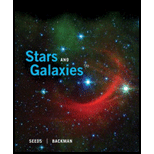
Stars and Galaxies
9th Edition
ISBN: 9781305120785
Author: Michael A. Seeds, Dana Backman
Publisher: Cengage Learning
expand_more
expand_more
format_list_bulleted
Concept explainers
Question
error_outline
This textbook solution is under construction.
Students have asked these similar questions
Given two extrasolar planets have a resonance of 1:3 and the planet closest to the star has an orbital period of 15 days what is the orbital period of the other planet?
G:06)
the co
te
on Pictor.
The
270
TOI
System
TOI 270 c
Earth
365-day orbit
$1 AU from Sun
Habitable
5.7-day orbit
0.05 AU
$2.4 Earth radii
Largest in
system
59 F, 15 C
300 F, 150 C
TOI 270
TOI 270 d
M3-type dwarf star
TOI 270 b
$11.4-day orbit
0.07 AU
3.4-day orbit
2.1 Earth radii
0.03 AU
Temperate
1.25 Earth radii
Likely rocky
150 F. 67 C
490 F. 254 C
Figure taken from https://exoplanets.nasa.gov/news/1593/tess-scores-hat-trick-with-3-new-worlds/
What makes the TOI-270 system particularly interesting is that the three exoplanets detected this far
(there may be more) have sizes comparable to the Earth.
Compare the orbital period of TOI 270 c and TOI 270 d. For every revolution that TOI 270 d makes around
the host star TOI 270, how many revolutions does TOI 270 c make?
Knowledge Booster
Learn more about
Need a deep-dive on the concept behind this application? Look no further. Learn more about this topic, physics and related others by exploring similar questions and additional content below.Similar questions
- The Sun was once thought to be a planet. Explain why.arrow_forwardF2 Planets in the habitable zone of their stars: 1 #3 3 O are so far from their stars that it is very difficult to discover them O are at a temperature where water can exist as a liquid on the planet's surface O are always the planets closest to the star are also called hot Jupiters O cannot exist around stars that are red dwarfs (spectral type M) E G D F3 $ 54 2 4 R F4 LL F DII % 5 Q Search F5 T 9 -0. G < 6 A F6 Y * F7 & 7 H PrtScn U FB 8 Home Jarrow_forwardIn 3–5 sentences, explain how the shape of planetary orbits affects their orbital velocity. Include the proper law of planetary motion as part of your answer. In 3–5 sentences, explain how the shape of planetary orbits affects their orbital velocity. Include the proper law of planetary motion as part of your answer.arrow_forward
- What will be the long-term future of our Galaxy?arrow_forwardThe time of the Cambrian explosion is listed on the second page of the Universe Bowl on the inside cover of the printed book. Express that time in scientific notation.arrow_forwardCalculate the orbital speed in km/s of the planet Threa given that the radius of the Threa's orbit is 1.5 x 108 km and 1 year lasts for 500 earth days. Assumptions: Threa's orbit is circular Threa's star is at the exact center of its orbitarrow_forward
- Complete sub question ( d ) (i) and (ii)arrow_forwardA planet very similar to earth is found to be orbiting its star at a distance of 1800 million km (I.e., 1800 × 10^6 = 1.8 × 10^9 km) with a period of 21 440 days. Calculate the mass of the star in units of solar masses.arrow_forwardA planet is located at < - 3×1010, 8×1010, - 5×1010 > m. A star is located at < 8×1010, - 5×1010, 5×1010 > m.arrow_forward
- Two planets, planet A and planet B, have the same surface gravity. However, planet B has twice the radius of planet A. How does the mass of planet B compare to the mass of planet A? The mass of planet B is four times the mass of planet A. The mass of planet B is equal to the mass of planet A. The mass of planet B is one-half the mass of planet A. The mass of planet B is twice the mass of planet A. The mass of planet B is one-fourth the mass of planet A.arrow_forwardSaturn is approximately 10 times as far away from the sun as the earth. If dark matter changed the orbital properties of the planets so that Saturn had the same orbital speed as the earth, Saturn’s orbital acceleration would be ________ that of the earth.A. 1/10B. 1/100C. 1/1000D. 1/10,000arrow_forwardWhich celestial object contains more mass? O Star O Galaxy O Nebula O Cometarrow_forward
arrow_back_ios
SEE MORE QUESTIONS
arrow_forward_ios
Recommended textbooks for you

 Stars and GalaxiesPhysicsISBN:9781305120785Author:Michael A. Seeds, Dana BackmanPublisher:Cengage Learning
Stars and GalaxiesPhysicsISBN:9781305120785Author:Michael A. Seeds, Dana BackmanPublisher:Cengage Learning Stars and Galaxies (MindTap Course List)PhysicsISBN:9781337399944Author:Michael A. SeedsPublisher:Cengage Learning
Stars and Galaxies (MindTap Course List)PhysicsISBN:9781337399944Author:Michael A. SeedsPublisher:Cengage Learning AstronomyPhysicsISBN:9781938168284Author:Andrew Fraknoi; David Morrison; Sidney C. WolffPublisher:OpenStax
AstronomyPhysicsISBN:9781938168284Author:Andrew Fraknoi; David Morrison; Sidney C. WolffPublisher:OpenStax Glencoe Physics: Principles and Problems, Student...PhysicsISBN:9780078807213Author:Paul W. ZitzewitzPublisher:Glencoe/McGraw-Hill
Glencoe Physics: Principles and Problems, Student...PhysicsISBN:9780078807213Author:Paul W. ZitzewitzPublisher:Glencoe/McGraw-Hill Foundations of Astronomy (MindTap Course List)PhysicsISBN:9781337399920Author:Michael A. Seeds, Dana BackmanPublisher:Cengage Learning
Foundations of Astronomy (MindTap Course List)PhysicsISBN:9781337399920Author:Michael A. Seeds, Dana BackmanPublisher:Cengage Learning


Stars and Galaxies
Physics
ISBN:9781305120785
Author:Michael A. Seeds, Dana Backman
Publisher:Cengage Learning

Stars and Galaxies (MindTap Course List)
Physics
ISBN:9781337399944
Author:Michael A. Seeds
Publisher:Cengage Learning

Astronomy
Physics
ISBN:9781938168284
Author:Andrew Fraknoi; David Morrison; Sidney C. Wolff
Publisher:OpenStax

Glencoe Physics: Principles and Problems, Student...
Physics
ISBN:9780078807213
Author:Paul W. Zitzewitz
Publisher:Glencoe/McGraw-Hill

Foundations of Astronomy (MindTap Course List)
Physics
ISBN:9781337399920
Author:Michael A. Seeds, Dana Backman
Publisher:Cengage Learning